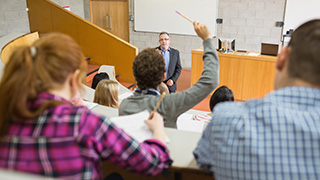Expanding skill development
In recent years, teaching methods on STEM courses have shifted to a more skills-focused approach, equipping students with not just subject-specific skills, but transferable skills and competencies that employers are seeking. EY’s research found that 48% of students chose their course to qualify for a specific career, or to improve their career prospects, which only emphasises the need for employability-focused curricula. Innovations seen in the Teaching Innovation Awards reflect this shift, with an increasing number of skills and employability-focused applications over the past four years.
Using badging for skills identification
To enhance practical skill development, educators are implementing enhanced technology and approaches such as augmented reality, badging techniques, Smart Worksheets, and LabSims. Dr Ryan Mewis and colleagues from Manchester Metropolitan University implemented the use of Moodle badges to showcase practical skill development for first-year chemistry students, earned by completing LabSims and other pre-lab exercises followed by laboratory classes to practise and demonstrate proficiency. Their approach enabled students to recognise their skills, with 71% of students surveyed agreeing that the badges helped them to identify the skills they were developing.
Building transferable skills
Educators’ dedication to preparing students for the working world is highlighted by a number of 2023 applications. From learning groups developing problem solving and critical thinking skills to global student projects focused on building the skills needed to make a difference in the world, the range of innovations demonstrates how science degrees can support transferable skills development as well as subject-specific content.
Enhancing student learning
With students looking for institutions that utilise digital technology and enhanced teaching strategies, it’s increasingly important that teaching and resources are engaging and support students every step of the way.
Enhancing student learning has always been a prominent theme of the Teaching Innovation Awards, and it was no different this year. Laboratory time is often a focus, due to the cognitive demands it can have on students, especially for those who lack lab experience. Dr Smita Odedra and Dr Linnea Soler from the University of Glasgow created a set of e-resources to combat this, supporting student transition into labs with videos, 360° images and interactive quizzes. All students surveyed believed that the resources would help them adjust to higher education chemistry, and reduce anxiety when entering labs.
Educators are also utilising new technology such as virtual and augmented reality to provide an engaging experience for students; whether that’s introducing immersive simulations for deeper understanding, using augmented reality to illustrate complex chemical structures, or co-creating VR resources with the students themselves.



.png)
